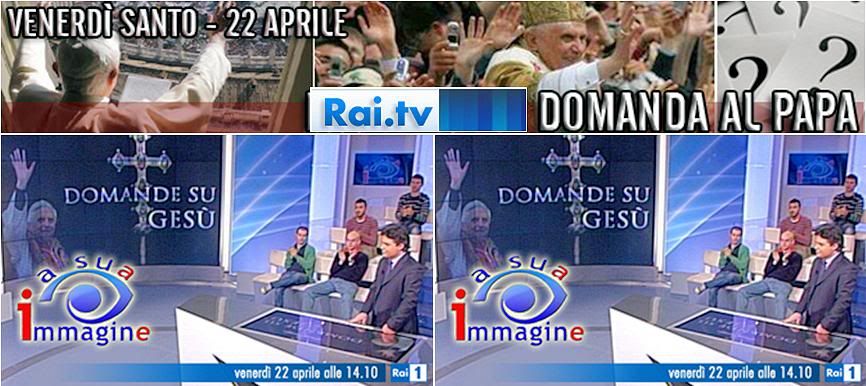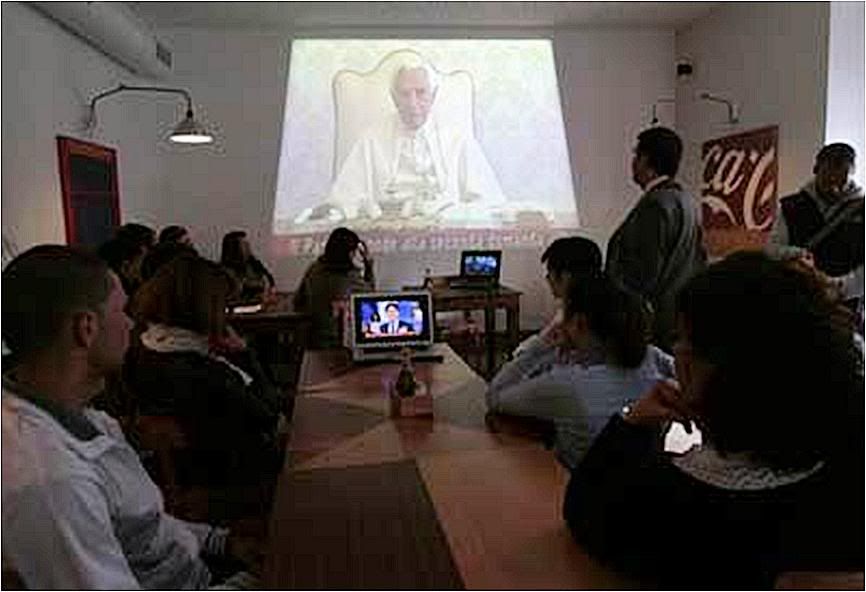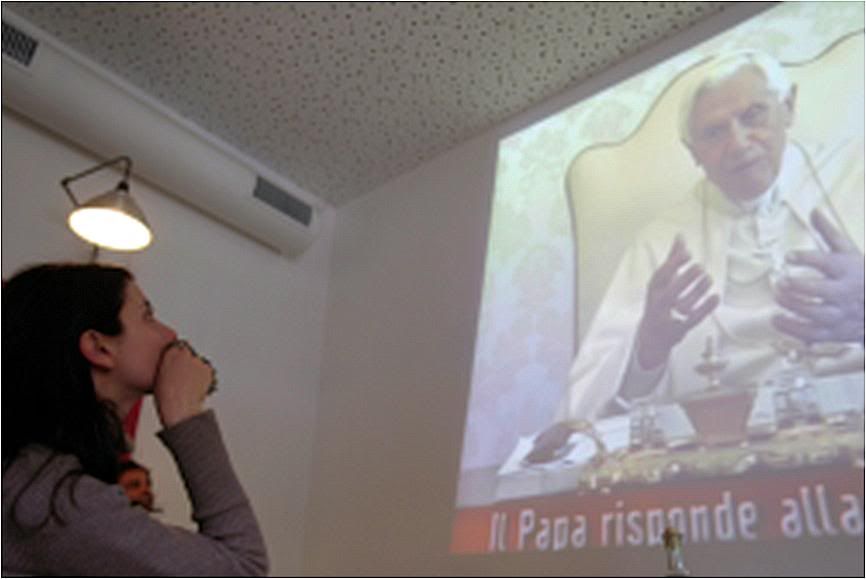 It seems that after all the hype in the Italian media the past several days, the special telecast at mid-afternoon today of the current affairs TV program 'A sua immagine' by Italian state TV - also carried by TV2000 of the Italian bishops' conference and Sky-TV in Italy - did not exactly come out as advertised,
It seems that after all the hype in the Italian media the past several days, the special telecast at mid-afternoon today of the current affairs TV program 'A sua immagine' by Italian state TV - also carried by TV2000 of the Italian bishops' conference and Sky-TV in Italy - did not exactly come out as advertised,

because the Pope's segment on the program was treated like any ordinary segment, and 'diluted' in the usual mindless chatter that characterizes commercial TV programs. One of the commentators on La Bussola Quotidiana has promptly denounced it...
No way to treat the Pope
by Riccardo Cascioli
Translated from

April 22, 2011
Can the Pope be used to promote a program? Unfortunately, yes, and it has happened - on Good Friday, no less - in RA-1's telecast of 'A sua immagine', which was supposed to do exactly the opposite, namely, to serve the Pope's words.
For days, the newspapers have been full anticipatory news about this telecast which was presented as "The Pope answers questions from the people". There was the programmed release of some excerpts of the Pope;s answers, in part or in full, to issues like the earthquake in Japan and persons in a vegetative state.
And so. most of Holy Week was a whetting of the public appetite for a TV event expected to attract millions of viewers.
Most of whom would have been greatly disappointed and perhaps deceived. Obviously not with the Pope, who was as usual precise and sensitive in his answers, which were understandable and reasonable to every type of question.
Rather, it was because it was obvious that the Pope's segment was treated as merely a side dish on a program menu that was largely set in the studio, with various other guests answering questions from viewers that had nothing to do with what the Pope had said.
Thus, the Pope's part was drowned in a sea of other words, mostly useless, as well as by the way the program was conducted, in a way more appropriate to the routine fare on commercial TV than for the flagship of Italian state TV. Not to mention the skits that were used to introduce the questions asked of the Pope!
A spectacle that, to say the least, left the viewer perplexed, and opens up two questions:
On the one hand, TV's indiscriminate lack of scruples in exploiting the Pope in this way. And on the other, how the Vatican itself 'manages the image' of Benedict XVI.
The Pope's participation in the program was a 'first' which, of course, deserved to have great resonance.
It is logical to expect that the Pope's close collaborators should have requested precise conditions and guarantees to make sure that the entire program itself and the intentions of its host would be in keeping with the Pope's participation. One has the impression that none of that took place.
It was equally evident that the management of RAI itself had never thought of it, and simply left it to the pure discretion of the program host how best to present the Pope's segment, instead of treating him like he had been an ordinary subject to which the program had deigned to devote a segment.
With the disconcerting result that millions of viewers can testify to!
John Allen, who has not written a word about the ope's recent birthday and anniversary, has filed a prompt report on the telecast, obviously focusing only on the Pope's segment:
Thoughts on Benedict’s Good Friday Q&A
by John L Allen Jr

April 22, 2011

In a move without any direct precedents, Pope Benedict XVI went on Italian television today to respond to seven questions chosen from among 3,000 submitted by ordinary people from all over the world. Although this was certainly not a hard-hitting “Meet the Press”-style encounter, the Pope’s answers nevertheless inevitably carry news interest.
The following are three quick observations about the importance of Benedict XVI’s television outing.
Communications Strategy
A Pope responding to questions from the general public on TV is a bit reminiscent of what Samuel Johnson once said of a dog walking on its hind legs – what’s striking is not so much how well he does it, but that he does it at all.
Similarly, at one level the important thing about Benedict’s TV appearance isn’t so much what he said, but the fact it happened.
In a nutshell, today’s television appearance – like Benedict offering the “Thought for the Day” on the BBC for Christmas eve, or the recent launch of a Facebook page for the beatification of John Paul II, or the new youth catechism – reflects the plain-as-potatoes fact that the Vatican has a communications problem, and is trying, in fits and starts, to do something about it.
It’s also a reflection of the Vatican’s understanding that Benedict XVI, left to his own devices, is often a very effective communicator. As a result, they’re looking for ways to showcase him – especially in venues in which the agenda isn’t set by the media, and in which the Pope’s words aren’t sliced and diced by a media filter.
One of Benedict’s gifts is the ability to express complex theological ideas in ways that don’t require a Ph.D. to grasp. Today, for instance, an Italian woman whose son has been in a vegetative coma for two years asked the Pope what happens to her son’s soul.
In response, Benedict XVI offered a homespun analogy: The soul is still present in the body, even if the body can’t express it – like a guitar, he said, with broken strings.
Benedict went on to express confidence that the son can still sense his mother’s love, and said her presence at his side is a great witness to faith in God and in life.
In terms of method, today’s broadcast thus can be understood as part of an emerging Vatican communications strategy to find opportunities for the Pope himself to speak about the essentials of the faith – apart from, and in addition to, trying to put out fires related to various crises in Catholic life.
The idea is to project a different and more positive storyline, taking advantage of the Pope’s chops as a communicator and his celebrity status as a newsmaker.
Outreach to Islam
Benedict’s post-Regensburg effort to reach out to Muslims was also palpable in today’s broadcast.
[But the Regensburg lecture itself was a message to Muslims about faith and reason! Except teh media hijacked the message and the Muslim world never saw beyond the quotation of Manuel II Paleologue!]
Benedict’s speech in Regensburg, Bavaria, in September 2006, memorably set off a firestorm of protest across the Islamic world for appearing to link Muhammad with violence. In the years since, Benedict has made outreach to the Islamic world a clear inter-faith priority.
Today, in response to a question from Iraq, Benedict XVI said he is praying for the persecuted Christians of Iraq and hopes they’ll find a way to stay rather than to emigrate.
Yet he says the Vatican is concerned not only for Iraq Christians but Muslims too, both the Shi’ite and Sunni communities, and says that the church wants to play a role in the construction of an Iraq based on diversity and dialogue.
Benedict also took a question from a Muslim woman in the Ivory Coast, the only one of the seven questions explicitly identified as coming from a non-Christian. The question dealt with the violence currently scarring that African nation.
In response, Benedict said that Jesus was a man of peace and that the Church wants to support peace initiatives, recalling that he has dispatched Cardinal Peter Turkson of Ghana, President of the Pontifical Council for Justice and Peace, as his personal envoy to the Ivory Coast to try to mediate the conflict.
It’s striking that the only non-Christian groups Benedict mentioned by name were Muslims, and the Vatican went out of its way to identify one of the questions as coming from a Muslim.
[It would have been a genuine surprise if any Jews had sent in any questions at all since the questions were supposed to be about Jesus. Also, why would the Pope bring themp up at all, consiering that one of their issues against him is the Good Friday prayer for the Jews in teh traditional Missal. An issue, by the way, tat they never raised, or at least not with such virulence, against other Popes like John XXIII and John Paul II who used 'stronger' versions of the Good Friday prayer.]
All this reflects the importance Benedict attaches to what he defined during his May 2009 trip to the Holy Land as an “Alliance of Civilizations” with Islam, especially vis-à-vis Western secularism.
A theologian, not a mystic
We also caught glimpses today of the fact that while Benedict XVI is a gifted theologian and a man of deep faith, he’s no mystic.
[A non sequitur conclusion, even if Benedict XVI himself flatly stated "I am no mystic' in the interview with Peter Seewald. Just because he chooses to answer 'folk questions' in practical down-to-earth terms does not necessarily mean he is not a mystic. John Paul II, whom most consider a mystic, would not have anwered such questions with high-flown mysticism either!]
The final three questions – about Jesus’s descent into Hell, his post-resurrection body, and the prospect of another papal consecration of the world to Mary – gave Benedict the chance to engage in some cosmic rumination or end-time speculation, and each time he demurred.
On the descent into Hell, Benedict said in effect that we shouldn’t get hung up on the details, that this was a journey of the soul rather than a physical movement across space. The point, he said, is that the salvation of Christ embraces all people regardless of when they lived – its effectiveness didn’t begin, he said, in the year 0 or 30.
Benedict also resists speculating much about the post-resurrection body of Jesus, preferring instead to focus on the real presence of Christ in the Eucharist.
Finally, in reply to the question on Mary, we got a further example of Benedict’s famed “Marian cool”.
Other Popes, he said – Pius XII, Paul VI, and John Paul II – all engaged in dramatic public consecrations of the world to Mary. Though he didn’t add the point himself, those actions usually came in response to pleas for such a consecration associated with great Marian apparitions, such as Fatima in Portugal.
At this stage, Benedict said, there’s no need for another “great act” of consecration.
[Characteristically, the Holy Father does not mention, of course, that he did perofrm such an Act of Consecration in May last year at Fatima!]
Instead, he said, what’s important is allowing our own hearts to be entrusted to Mary. Because Mary is the image of the church, he said, that also implies entrusting ourselves to the church, loving the church as a mother.
In all three instances, Benedict took questions that seemed to invite an esoteric response and turned it into an occasion for delivering a fairly simple pastoral message.
[Again, Benedict XVI knows the questions are 'pastoral' rather than didactic in nature, and he knows the general audience that the program is intended for. Why would he even think of givng an esoteric response???? Even the most 'technical' parts of his books are presented adn explained so that they do not sound esoteric! ]
That, too, could be seen as an expression of his desire to communicate effectively – and his ability to do so, at least when the time, place and subjects are basically under his control.
Allen made some good points in his article, but he has a tendency to over-analyze. Joseph Ratzinger never had any difficulty communicating effectively all his life - they didn't call him Goldmund at university for nothing.
The Regensburg lecture was delliberately distorted in the reporting, and if he had been able to announce 'informally' the lifting of excommunication from the FSSPX bishops - rather than through teh formal decree alone] - he would have made clear the process of excommunication, when it is done, that it is tied to a specific action or circumstance by the excommunicated individual and not to the totality of their being, the specific reason that these four bishops were excommunicated, and and what the revocation of excommunication means in their individual cases.
[Modificato da TERESA BENEDETTA 23/04/2011 04:27]